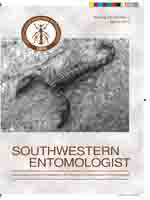Scanning electron microscopy was used for comparison of the morphological basis for host detection and mating behaviors by olfactory reception in two psyllid species, the Asian citrus psyllid, Diaphorina citri Kuwayama, and potato/tomato psyllid, Bactericera cockerelli (Sulc) (Hemiptera: Psyllidae). The two psyllids inhabit different plant niches. The Asian citrus psyllid is essentially monophagous, feeding primarily on citrus, but the potato psyllid feeds on a wide range of solanaceous plants. This study identified two antennal sensory arrays, with a more complex arrangement occurring in the Asian citrus psyllid than potato psyllid. The antennal length of the Asian citrus psyllid was 0.23 mm and contained 10 segments, while the antenna of the potato psyllid was 0.60 mm long with 10 segments. Both species had two multi-porous, single-walled bristles apical to the sensillus terminalis. These bristles were longer in potato psyllids. A few mechanosensory and chemosensory hairs were found on all antennal segments of both species, with more sensillae on distal segments. Asian citrus psyllid coevolved with its citrus host in tropical Asian countries; locating the strongly aromatic plants probably was less difficult. Asian citrus psyllid females would be constrained to a specific host plant, facilitating mate detection. Potato psyllid has fewer olfactory sensilla and feeds on a wider host range. A wide host range suggests that potato psyllid may have increased sensitivity to specific chemical cues required to locate mates that could be on different species of host plants.
How to translate text using browser tools
1 March 2012
Comparative Analysis of Antennae Sensory Arrays in Asian Citrus Psyllid, Diaphorina citri, and Potato Psyllid, Bactericera cockerelli (Hemiptera)
Janet Arras,
Wayne Hunter,
Blake Bextine
ACCESS THE FULL ARTICLE

Southwestern Entomologist
Vol. 37 • No. 1
March 2012
Vol. 37 • No. 1
March 2012




